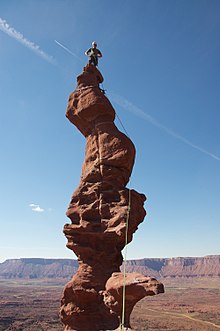

Exposure is a climbing and hiking term. Sections of a hiking path or climbing route are described as "exposed" if there is a high risk of injury in the event of a fall because of the steepness of the terrain. If such routes are negotiated without any protection, a false step can result in a serious fall.[1] The negotiation of such routes can cause fear of falling because of the potential danger.
What constitutes exposure on a path is fairly obvious, however, an "exposed" location or section of a climbing route is not uniformly or clearly defined in the literature. There are no threshold values, for example, based on the gradient of the terrain, the height of rock faces or the character of a ridge or arête. Authors tend to use their own definition of the terms "exposure" or "exposed" when describing routes, for example:
"Exposed" sections of a path or a route can cause fear as well as serious problems for climbers and walkers in mountainous terrain if they lack a head for heights. However, what may feel exposed to some people, may hardly affect others at all. In critical situations it is therefore necessary, either to turn back or to use a protective measure such as a rope; some paths have fixed ropes, chains, ladders, etc. The anxiety caused by the exposure reduces with habituation, but even experienced climbers often have to get used to heights again at the start of the climbing season.[7]